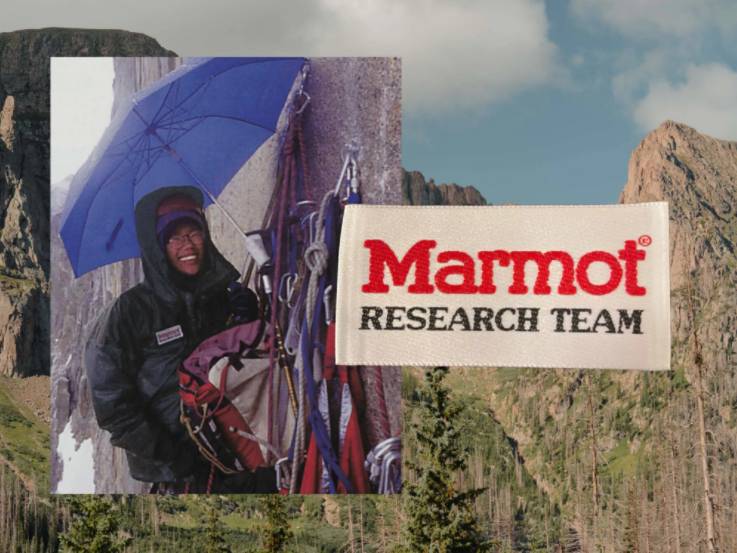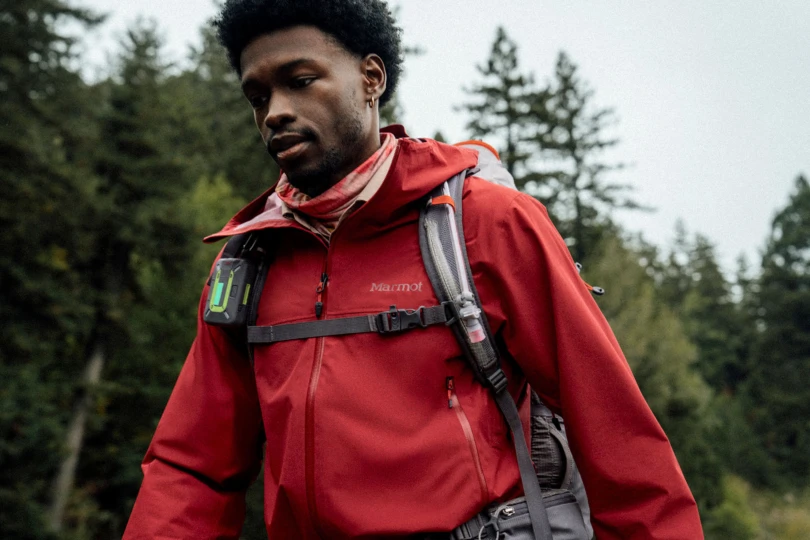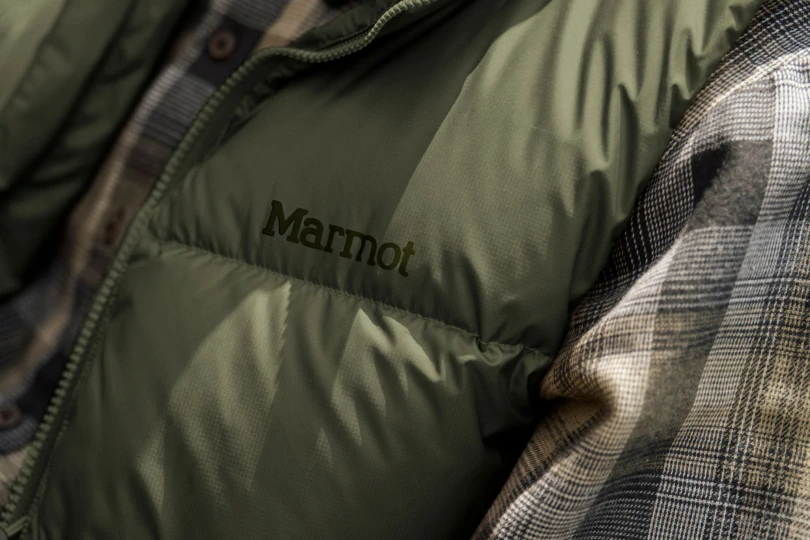In the Pantheon of outdoor brands reside hallowed names that everyone knows, from alpinists and ultra-runners to car campers and festival goers. These companies feel like pillars of the $1 trillion outdoor recreation industry, and the average consumer might assume they enjoy tenured status on REI’s shelves.
The short list includes Patagonia, Columbia, The North Face, and, for many, Marmot. Founded more than a half-century ago, it’s one of the oldest brands you’ll find at a gear shop. And while its rise to prominence saw its PreCip rain shell become as much of a staple as the original Patagonia fleece, Marmot’s innovation waned in recent years.
To be sure, Marmot didn’t just stop; it continued to make tents and apparel. But the brand became less of a fixture when it came to new product launches and exciting, cutting-edge gear. The situation came to a head when the outdoor industry podcast, The Rock Fight, lamented Marmot as the poster child for “zombie brands” — that is, recognizable brands that carry on but lack the drive and innovation that once defined them.
But at this summer’s Outdoor Market Alliance (OMA) gear show, the vibe around Marmot was distinctly different. Sales reps were eager to show editors what’s on tap and ready to test for 2026 and beyond. Is the buzz justified, or just hype? GearJunkie spoke with Marmot Vice President and General Manager of Technical Apparel Jon Graden to find out.
Interview: Why the Future Looks Bright for Marmot
GearJunkie: On The Rock Fight, the phrase “zombie brand” came up. What did that mean to you?
John Graden: I told [the host] Colin: You wouldn’t talk about us if you didn’t love Marmot and want us to win.
Part of the criticism was fair. In 50 years, every brand has ups and downs. Marmot hadn’t really had a down — until recently. I saw it as an opportunity to acknowledge missteps and show what we’re doing to reignite the brand.
We’re still the fourth-most recognizable brand in the industry, with strong consumer affinity. Now it’s about fuel on the fire, leaning into what’s true about Marmot.
Our brand values: “Heritage,” 50 years of credibility; “innovation,” practical, meaningful innovation; “proven performance,” products that deliver on their promise; “welcoming Spirit,” democratizing the outdoors; and “lightly unconventional,” embracing our quirky Marmot personality.
We’re a little “lo-fi” but with high-performing gear — authentic and approachable, not flashy. Like Subaru: quirky, true to itself, with a fiercely loyal fan base.
It seemed that in the last handful of years, we didn’t see a lot of boundary-pushing gear coming from Marmot. Do you think that’s accurate, or was that perception off?
Probably a little of both. We were acquired by our parent company [Newell Brands] in 2016, and at that time, Marmot was the only high-price-point apparel and gear company in the portfolio. The question was, “What do we do with this brand, and how do we incorporate it?”
Some assumptions about how far you could stretch Marmot proved to be incorrect.
We got off our innovation cadence and weren’t first to market with groundbreaking ideas like we had been in the past. Historically, Marmot’s strength was “usable innovation,” practical gear that delivered performance without being gimmicky.

We also went after a younger consumer — Gen Z, Gen Alpha — leaning into retro styling, oversized fits, and bold color palettes. That wasn’t what our core customer wanted. Our strength has always been consumers aged 30–49; people with disposable income, who are active outdoors and want reliable gear. When we chased trends, we alienated our loyal fans.
We’ve fixed that. The pandemic created more disruption — apparel softened while equipment spiked, then leveled off after vaccines rolled out. Between those events and the brand direction missteps, we lost ground.
In the past 2 years, our focus has been returning to what made Marmot great: practical, high-performing, approachable gear.
That 30–49 age range you mentioned — what defines that group? Beyond disposable income, what characterizes them?
We recently conducted consumer research. At a high level, we see two main groups: The Enthusiast, who’s outdoors one to eight times a month — camping twice a month, for example. And the Occasionalist, who’s outdoors one to eight times a year, maybe camping once annually.

Geography also plays a role. Someone in Boulder might ski often; someone in Kansas City might ski once a year because of travel barriers. For our team, it was critical to design and market with that clarity.
And importantly, outdoor consumers today aren’t defined solely by the “sufferer at the summit.” Our industry needs to democratize the outdoors and make it welcoming for everyone. Post-pandemic, participation is higher than pre-pandemic, so the opportunity is bigger.
We’re focusing on gear across the spectrum: not just pinnacle products but also accessible items like a great $100 rain jacket. When we launched the PreCip rain shell 25 years ago, we disrupted the market at that price point. That democratized technical gear and created legions of fans. We want to do that again.
Sounds like a challenge: Keeping gear accessible while also driving innovation. How do you balance that?
Good question. When we chased Gen Z, we leaned on archival reissues — retro silhouettes, bold colors. Cool visually, but not cutting-edge in performance. That diluted our message.
Now, we’re focused on dual-purpose innovations that appeal to both enthusiasts and occasionalists. For example, the Wraptor sleeping bag is innovative, accessible, and fun. Enthusiasts see performance, occasionalists see usability.
Looking ahead to 2027, we’ll reintroduce more GORE-TEX and Pertex shells, doubling down on high-performance. Our GORE-TEX shell, at $275, is one of the most affordable in the market, and demand has spiked.
Which brands do you think are doing this balance well?
Rab is a great example — accessible, cool, performance-driven, and consumer-focused. They’re a bit of a North Star for us.
We don’t want to be just for the ice-beard sufferer anymore. Younger Gen X and older Millennials want versatility. Instead of traditional zip-off hiking pants, today’s consumer might wear Vuori leggings with a Marmot fleece and shell.
We’re embracing that athleisure influence while staying true to our outdoor DNA.




Is the PreCip still the product Marmot is best known for?
Yes, though we also have a strong heritage in gear: Trestles sleeping bags, Tungsten and Limelight tents.
For some consumers, it’s apparel; for others, it’s equipment. They feed each other — gear bolsters our credibility, which lifts apparel. We’re investing in new design talent, especially in equipment, to regain ground against faster-moving competitors.
In 5 to 10 years, do you think Marmot will be known for something different?
Absolutely. The challenge I’ve set for my team is, how do we build new icons?
Legacy products like PreCip and Tungsten are great, but we need what’s next. Innovation cycles are shorter now; consumers expect more frequent, noticeable newness. Beyond lighter, warmer, drier, sustainability and circularity are becoming non-negotiable.
California’s new circularity laws require manufacturers to repair, resell, recycle, or break down returned gear. Europe is ahead on this already. Consumers also demand durability — buy less, buy better. That’s always been Marmot’s story, and we’ll be amplifying it in 2026.




When GearJunkie met with Marmot reps at OMA, they seemed genuinely energized about Marmot’s future. What’s driving that?
It’s the collective effort. When I joined, we tackled broken systems immediately — product, marketing, sales, planning. It’s exhausting but energizing because the whole team is aligned. Everyone wants Marmot to win.
Concrete examples: We updated the PreCip with stretch fabric, matte finishes, and modern design. Reception has been excellent. We’ve launched influencer partnerships for the first time, and feedback has been strong.
We’re also exploring returning to packs and duffels — no firm plan yet, but it’s promising.
If you had to boil it down into a sentence, what’s Marmot’s message for 2026 and beyond?
“Marmot: a trusted, beloved brand returning to leadership by staying true to what made it great — while evolving to meet the needs of today’s outdoor consumer.”




What upcoming gear are you most excited about?
The 2026 Comfort Wrap sleeping bag. It’s high-performing, easy to use, and fun — slightly unconventional in a way that feels very Marmot.
For 2027, we’re working on an ultralight tent to compete at the pinnacle level, plus value-oriented sleeping bags to strengthen entry points. It’s about clear segmentation, thoughtful pricing, and balancing enthusiast gear with approachable options.
That sounds straightforward — but if it were easy, Marmot would have been doing it already. What’s the hardest part?
Turnarounds take time — usually 3 years. You need to align vision, execute, earn consumer and wholesale buy-in, and deliver sell-through, not just sell-in.
Right now, we’re at the midpoint. Our comps should be strong this back half, thanks to improved color palettes, a relaunch of our Guides Down jacket, and expansion into lightweight insulation — a category we underrepresented.
The challenge is maintaining momentum, proving results, and using those proof points to shape the next chapter.
Read the full article here





